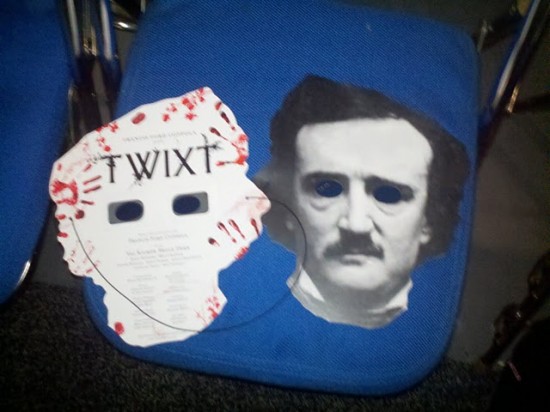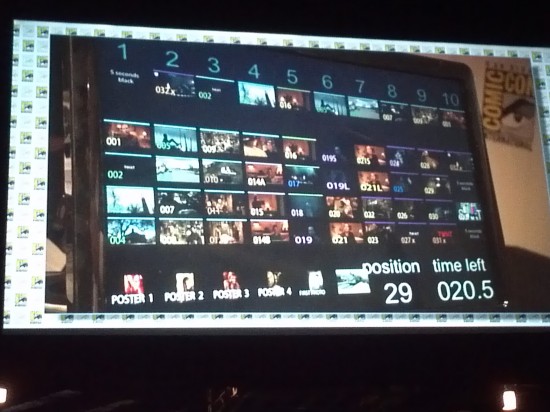With 'Twixt,' Francis Ford Coppola Wants To Create A Live, Dynamic Cinema Experience
One word: inspiring. Today Francis Ford Coppola made his first appearance at the San Diego Comic Con since 1991, bringing with him the electronic musician Dan Deacon and actor Val Kilmer. Those two men were among his collaborators on a new film called Twixt, which is a sort of gothic horror story / murder mystery set in a small northern California town. But Twixt, the movie, was only part of the panel and, frankly, it was the least part of why today's event is the best thing I've ever seen in Hall H at Comic Con.
The real hook with Twixt is what Mr. Coppola wants to do with it: he plans a 30-city tour later this year in which he and Dan Deacon, and possibly other talents, will create a dynamic assembly of the film as it plays to each audience. Essentially, they have a great deal of footage which adds up to a movie called Twixt, but depending upon where and when you see the presentation, you might see a totally different telling of the story than others. In other words: 'Remixd'? Something like that.
There's a lot of material to cover here, and I'll begin with a description of the footage and then move into a recap of the panel, after the break.
Let's begin with the footage. What we were shown at first follows a hack horror writer (Val Kilmer) as he enters Swan Valley, where he is set to do a book signing. (At a hardware store, as it turns out. Indignity!) Tom Waits narrates our first pass through the town, introducing local elements such as a clock tower with many faces that show different times, and a group of 'vampire' kids that camp at the edge of town, led by "Flamingo, a seducer of innocent youth," played in exaggerated goth/vampire makeup by Alden Ehrenreich.
Val Kilmer's character is tormented by his inadequacy and the fact that he needs to write crappy books to make a living. ("I write because of the incessant financial burdens that found me," which is seemingly a very personal note from Mr. Coppola.) But he is introduced both to a current murder mystery by Bruce Dern (who also demonstrates "an electric chair for killing vampires") and to an older local murder legend. That latter murder story comes via a dream in which Edgar Allan Poe (Ben Chaplin) converses with the writer.
There is a lot more — very funny moments of Kilmer's character trying to write; dream sequences in black and white that are sometimes very old-school from a technological standpoint; a very Twin Peaks-like vibe in the Swan Valley town area; and conversations with what seems to be the spirit of a dead girl (Elle Fanning).
Most of the footage looked great, and Mr. Coppola explained that as he didn't like wearing glasses to watch 3D films ("I watched Avatar, but took the glasses off for much of the movie") he will present Twixt with only certain segments in 3D.
About the story — seem confusing so far? Maybe so. The use of 3D is a pretty old-school approach to the movie, but there is a lot about Twixt that represents what the director called "the evolving technology of the cinema." At the head of the panel, he talked about the fact that cinema is a young art form, only over one hundred years, and still evolving. He bemoaned the idea that cinema now is what cinema will be.
Cinema is so young! How dare anyone think all it has got up its sleeve is more 3D where the ticket prices go up? Cinema is a baby. Of course we're going to see wonderful innovations come; there will be many.
So the meat of the Twixt presentation was a demonstration of an iPad controlled system by which unique edits of the film could be created on the fly. Here's the interface, thanks to @jonniechang:
What followed was a demonstration of the possibilities of this system in practical use. Mr. Coppola created a couple different versions of the first trailer by reassembling the order of the scenes, sometimes showing much longer versions of various bits of dialogue. We essentially watched him edit the movie, to some degree, on the fly, and that's what's promised for the tour. To amuse himself and the crowd, he even put the system on 'shuffle' and we watched what it churned out — a workable assembly trailer that was quite different from the others. The presentation was a bit glitchy, but the panel participants got through the problems with the tech using humor and charm. It was a dress rehearsal, as they explained, rather than a final performance.
The panel participants were given a standing ovation before and after the panel, and throughout the experience the audience seemed to be totally in the palm of Mr. Coppola's hand. That to me was more important than anything else — there is an audience that is completely willing to go along with this experiment. They may even be hungry for it. Twixt, as a film or a narrative, may not be the next step of cinema. But seeing Francis Ford Coppola experiment is fascinating, and I'm thrilled I was there to experience it. I expect many other attendees today felt the same.
There are a lot of questions to ask about this approach to filmmaking, primary among which is whether or not there is one 'master' narrative that he conisders primary among all others, and then also what the idea of tweaking/remixing the story on the fly says about the construction of a film narrative.Putting certain shots or sequences before others can have a huge effect on their meaning, and by changing the rigor of how footage is ordered, what does that do to the very notion of telling a nuanced film story? I'm eager to discover these answers.
These are the 3D 'glasses' that were handed out before the panel:


